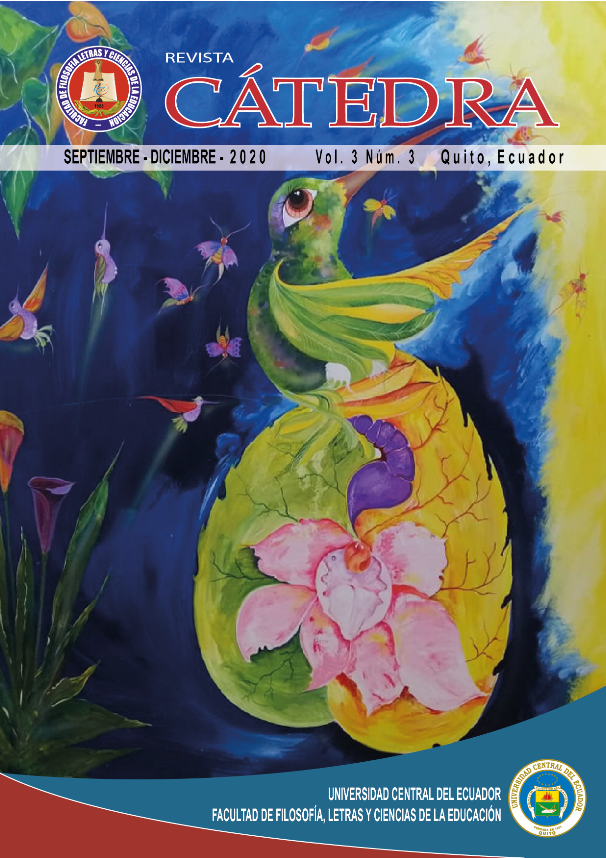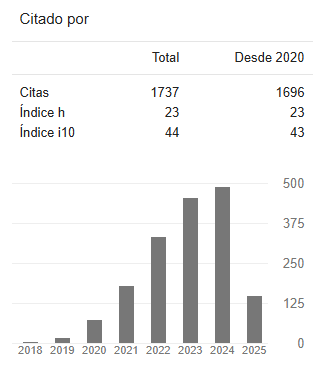Neurolinguistic programming as an innovative strategy for language and literature teaching
DOI:
https://doi.org/10.29166/catedra.v3i3.2430Keywords:
Didactics, Language, Literature, Neurolinguistic Programming, rapport, representational systemsAbstract
This article is the result of research with a quali-quantitative approach. The purpose was to collect information and theoretical data to understand and explain how Neurolinguistic Programming (NLP) can through the new studies of Language and Literature Didactics (DLL) contribute to its development. The aim is to get teachers to connect with the world of students. NLP strategies have been adapted to language classes in a didactic way and the role of emotions in the development of the teaching-learning process is taken into account. The statistical data obtained through a descriptive survey helped to understand how teachers work with students and how they respond to the applied learning model. Therefore, it was concluded that this model does not respond to current needs. The proposal proposed provides new tools to the teacher to achieve significant learning taking into account the needs and interests of students. For this, the study is centered in the different techniques of the NLP, applicable in the classroom as: knowledge of the representational systems that exist to feel and know the world that surrounds us, how the levels of logical thought work and how they affect the behavior, rapport strategies to tune in group and even strategies to improve the spelling with the NLP.
Downloads
References
Artavia Granados, J. M. (2005). Actitudes de las docentes hacia el apoyo académico que requieren los estudiantes con necesidades educativas especiales.
Bronckart, J. P. (2004). Actividad verbal, textos y discursos: por un interaccionismo socio-discursivo. Fund. Infancia y Aprendizaje.
Bandler, R., & Grinder, J. (1975). The structure of magic (Vol. 1). Palo Alto, CA: Science and Behavior Books.
Churches, R., y Terry, R. (2000). PNL para profesores: cómo ser un profesor altamente eficaz. Editorial Desclée de Brouwer.
Churches, R., y Terry, R. (2009). PNL para profesores. Cómo ser un profesor altamente eficaz. Bilbao: Desclée De Brouwer
Dobrinsky, M. (2007). PNL . Ediciones LEA.
Ejecutiva, F. (2011). Ley Orgánica de Educación Intercultural. Segundo Suplemento del Registro Oficial. http://www. wipo. int/edocs/lexdocs/laws/es/ec/ec099es. Pdf
Goleman, D. (1995). Emotional intelligence. New York, NY, England.
Grinder, J., y Bandler, R. (2007). De sapos a príncipes: Transcripción del seminario de los creadores de la PNL. Editorial Cuatro Vientos.
Hymes, D. H. (1971). «Acerca de la competencia comunicativa». En Llobera et al. (1995). Competencia comunicativa. Documentos básicos en la enseñanza de lenguas extranjeras. Madrid: Edelsa.
Ibáñez-Salgado, N. (2011). Aprendizaje-enseñanza: mejora a partir de la interacción de los actores. Educación y educadores, 14(3), 457-474.
Ley Orgánica de Educación Intercultural. Registro Oficial del Ecuador. Quito, Ecuador. 31 de marzo de 2011.
Marland, M. (1985). El arte de enseñar:(técnicas y organización del aula) (Vol. 10). Ediciones Morata.
Mendoza A. (2003). Didáctica de la Lengua y la Literatura. Madrid: Prentice Hall.
Mohl, A. (2017). El aprendiz de brujo. Editorial Sirio S. A.
Palacios, C. G. (2013). Caracterización de la comunicación pedagógica en la interacción docente-alumno. Investigación en enfermería: Imagen y Desarrollo, 15(2), 65-93.
Romo, Pablo (2017). Didáctica de la comunicación oral. Ediciones Ecuafuturo. Quito
Zapata, J. (2007). Análisis del proceso enseñanza-aprendizaje en la interacción maestro-alumno. Congreso El papel de la educación en la construcción de las sociedades del conocimiento, Universidad Autónoma de Nuevo L
Downloads
Published
Versions
- 2021-01-07 (2)
- 2020-09-29 (1)









